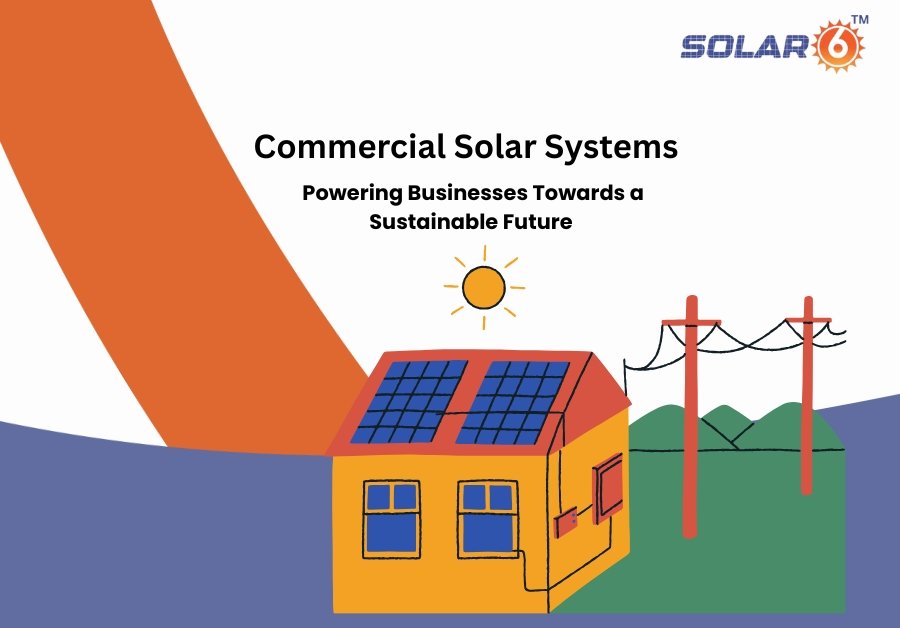As the world transitions toward cleaner and more sustainable energy sources, the commercial solar system has emerged as a powerful solution for companies aimed at reducing operating costs and environmental impacts. With rising electricity prices, an increase in awareness of climate change, and attractive state incentives, businesses of all sizes are looking for the benefits of solar energy. Installing a commercial solar system is not just an environmentally friendly decision-this is a smart economic step that increases energy reliability and long-term profitability.
In this article, Solar6 explores what commercial solar systems are, how they work, their benefits, financial implications, installation process, maintenance needs, and why they are rapidly becoming the future of business energy.
What Are Commercial Solar Systems?
Commercial solar systems are massive-scale solar panel installations designed to deliver easy power to agencies, factories, warehouses, workplaces, retail stores, and various business centers. Unlike residential systems that cater to family energy needs, business solar systems are engineered to handle larger electricity loads and are tailored to the power usage styles of commercial enterprise operations.
These systems normally encompass solar photovoltaic (PV) panels, inverters, mounting systems, wiring, and, once in a while battery storage. Thesolarn panels are typically set up on rooftops, carports, or ground-hooked up arrays, relying on the space to be had and power needs of the commercial enterprise.
How Do Commercial Solar Systems Work?
The functioning of a commercial solar machine is primarily based on photovoltaic technology:
Solar Panels Capture Sunlight: Solar panels soak up daylight and convert it into direct present day (DC) electricity.
Inverter Converts DC to AC: The DC electricity generated by way of the panels is sent to an inverter that transforms it into alternating modern-day (AC), which is used to energy enterprise operations.
Power Distribution: The converted power is distributed across the ability’s electrical infrastructure to power lighting, machinery, HVAC systems, computers, and various home equipment.
Net Metering or Battery Storage: Excess electricity generated in the course of the day can be sent returned to the grid via net metering, incomes credit in your application invoice, or saved in batteries for later use.
Key Benefits of Commercial Solar Systems
1. Significant Cost Savings
One of the number one blessings of business sun structures is the ability for considerable financial savings on energy payments. Businesses that install solar can reduce their dependence on grid power, which maintains to upward push in fee 12 months after year. Over time, these savings can quantity to tens or even loads of hundreds of dollars, relying on the dimensions of the device.
2. Return on Investment (ROI)
While the initial price of a commercial solar machine may appear high, it’s an investment that will repay. With proper planning, many companies see a return on investment within three to five years, after which the system continues to generate free energy for decades.
3. Environmental Impact
Solar electricity is clean and renewable. By switching to the sun, groups can appreciably reduce their carbon footprint, supporting combat weather trade and meet company sustainability goals. A normal commercial solar setup can save you masses of metric heaps of carbon dioxide from getting into the ecosystem every 12 months.
4. Energy Independence
By generating their very own electricity, organizations emerge as much less reliant on application providers and less susceptible to price fluctuations and power outages. This power independence enhances operational reliability and enterprise continuity.
5. Improved Brand Image
Modern consumers and partners prefer to engage with environmentally responsible businesses. A solar-powered facility enhances brand reputation, attracts eco-conscious customers, and demonstrates a company’s commitment to sustainability and innovation.
Financial Incentives and Government Support
Governments around the world are encouraging the adoption of renewable energy through various incentives:
Tax Credits: Many regions offer tax credits for solar installation. For example, in the United States, the federal Investment Tax Credit (ITC) allows businesses to deduct 30% of the installation cost from their federal taxes.
Accelerated Depreciation: Businesses can take advantage of programs like MACRS (Modified Accelerated Cost Recovery System) that allow for rapid depreciation of solar assets.
State and Local Incentives: Depending on location, additional state-level rebates, grants, and performance-based incentives may be available.
Net Metering Policies: Net metering allows businesses to sell excess electricity back to the grid, earning credits or income that offset the cost of energy consumption during non-solar hours.
Types of Commercial Solar Installations
1. Rooftop Solar Systems
Rooftop installations are the most common, making use of existing roof space on warehouses, office buildings, or retail outlets. These systems are cost-effective and often require minimal site preparation.
2. Ground-Mounted Systems
Ideal for businesses with ample land, ground-mounted systems can be installed at optimal angles for maximum energy production. They are often used by manufacturing facilities or logistics hubs.
3. Solar Carports
Solar panels mounted on carports provide dual benefits—shading for parked vehicles and clean electricity generation. They are an excellent solution for office complexes, shopping malls, and hospitals.
4. Hybrid Systems with Battery Storage
These systems combine solar panels with battery storage to provide backup power during grid outages and enhance energy reliability, especially in areas with an unstable power supply.
The Commercial Solar Installation Process
1. Site Assessment
A solar provider assesses the energy needs, roof condition, shading, and available space. An energy audit is typically conducted to analyze usage patterns.
2. System Design
Engineers lay out a customized sun system tailor-made to the business’s strengths, necessities, budget, and site situations. This consists of deciding on panel kinds, inverter models, and layout.
3. Permitting and Documentation
The provider handles all essential lets in, software approvals, and incentive packages.
4. Installation
Professional technicians install the system—panels, inverters, wiring, and mounts. The period relies upon device length, however, most industrial installs are finished in a few weeks.
5. Inspection and Commissioning
Local government checks out the system for code compliance. Once authorised, the gadget is commissioned and begins generating electricity.
Maintenance and Monitoring
Commercial solar systems require minimal upkeep. Most panels are designed to final 25–30 years with little overall performance degradation. Key aspects of maintenance consist of:
Regular Cleaning: Dust, brid droppings, and particles can lessen panel efficiency. Cleaning every 6–12 months helps maintain gold standard output.
System Monitoring: Smart monitoring systems offer real-time records on strength production and gadget health, allowing quick identification of problems.
Periodic Inspections: Annual tests by way of specialists ensure all components—especially inverters and wiring—are functioning successfully.
Challenges and Considerations
While commercial solar offers many advantages, there are also a few challenges:
Upfront Cost: Initial funding can be big. However, financing alternatives like leases, power buy agreements (PPAs), and loans could make it greater accessible.
Space Requirements: Limited roof or land area may also restrict machine size and output.
Energy Storage Costs: Battery structures, even as beneficial, can drastically growth prices.
Regulatory Hurdles: Permitting, grid approvals, and compliance can vary by way of area and require time.
Despite those, most groups discover that the long-term advantages far outweigh the limitations.
Commercial Solar Case Studies
1. Large Retail Chain
A major retail chain installed solar systems across 100 of its locations, reducing electricity bills by 40%. The company achieved full ROI in four years and now saves over $5 million annually on energy costs.
2. Manufacturing Plant
A manufacturing company in an industrial zone installed a 1 MW rooftop solar system. The system supplies 60% of its daily energy needs, significantly cutting overhead costs and boosting its sustainability profile.
3. School Campus
An educational institution installed solar carports, reducing energy costs while providing shade for student and staff vehicles. It also integrated the project into its environmental curriculum.
Future Trends in Commercial Solar
Energy Storage Integration: Batteries will become more common as charges fall and reliability becomes a priority.
Smart Solar Systems: AI and IoT technologies will optimize electricity management and predictive renovation.
Solar-as-a-Service: Subscription-primarily based solar models will develop, permitting agencies to go solar with zero prematurely fees.
Green Building Standards: More commercial homes will aim for LEED and different green certifications, where the sun plays a central role.
Conclusion
Commercial solar systems are transforming how groups consider electricity. They offer a powerful aggregate of price savings, environmental responsibility, energy independence, and more desirable emblem value. As the sun era continues to emerge and come to be extra available, there has never been a better time for businesses to invest in clean electricity.
Whether you operate a factory, workplace, retail store, or institution, switching to solar is a forward-thinking move that benefits your bottom line—and the planet.

